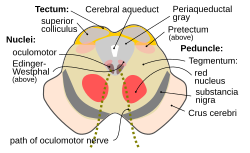
Back باحة أمام السقفية Arabic Àrea pretectal Catalan Area pretectalis German Προτετραδυμική περιοχή Greek Pretectum Spanish 덮개앞구역 Korean Предкрышечная область Russian Претектална област Serbian
| Pretectal area | |
|---|---|
 Cross section of the midbrain at the level of the superior colliculus. Pretectal area labeled (as pretectum) at right. | |
| Details | |
| Part of | Midbrain |
| Parts | anterior pretectal nucleus, medial pretectal nucleus, nucleus of the optic tract, olivary pretectal nucleus, posterior pretectal nucleus, posterior limitans, commissural pretectal area |
| Identifiers | |
| Latin | area praetectalis |
| MeSH | D066250 |
| NeuroNames | 467 |
| NeuroLex ID | nlx_59721 |
| TA98 | A14.1.08.505 A14.1.08.506 |
| TA2 | 5739 |
| FMA | 62402 |
| Anatomical terms of neuroanatomy | |
In neuroanatomy, the pretectal area, or pretectum, is a midbrain structure composed of seven nuclei and comprises part of the subcortical visual system. Through reciprocal bilateral projections from the retina, it is involved primarily in mediating behavioral responses to acute changes in ambient light such as the pupillary light reflex, the optokinetic reflex, and temporary changes to the circadian rhythm.[1][2][3][4][5] In addition to the pretectum's role in the visual system, the anterior pretectal nucleus has been found to mediate somatosensory and nociceptive information.[6][7]
- ^ Gamlin PD (2006). "The pretectum: connections and oculomotor-related roles". Neuroanatomy of the Oculomotor System. Progress in Brain Research. Vol. 151. pp. 379–405. doi:10.1016/S0079-6123(05)51012-4. ISBN 9780444516961. PMID 16221595.
- ^ Magoun HW, Ranson SW (May 1935). "The central path of the light reflex: a study of the effect of lesions". Archives of Ophthalmology. 13 (5): 791–811. doi:10.1001/archopht.1935.00840050069006.
- ^ Neuhuber W, Schrödl F (November 2011). "Autonomic control of the eye and the iris". Autonomic Neuroscience. 165 (1): 67–79. doi:10.1016/j.autneu.2010.10.004. PMID 21071284. S2CID 35330212.
- ^ Donkelaar H (2012). Clinical neuroanatomy brain circuitry and its disorders (1st ed.). Berlin: Springer. p. 343. ISBN 978-3642191336.
- ^ Miller AM, Miller RB, Obermeyer WH, Behan M, Benca RM (August 1999). "The pretectum mediates rapid eye movement sleep regulation by light". Behavioral Neuroscience. 113 (4): 755–65. doi:10.1037/0735-7044.113.4.755. PMID 10495083.
- ^ Bosman LW, Houweling AR, Owens CB, Tanke N, Shevchouk OT, Rahmati N, Teunissen WH, Ju C, Gong W, Koekkoek SK, De Zeeuw CI (1 January 2011). "Anatomical pathways involved in generating and sensing rhythmic whisker movements". Frontiers in Integrative Neuroscience. 5: 53. doi:10.3389/fnint.2011.00053. PMC 3207327. PMID 22065951.
- ^ Reis GM, Rossaneis AC, Silveira JW, Prado WA (June 2012). "μ1- and 5-HT1-dependent mechanisms in the anterior pretectal nucleus mediate the antinociceptive effects of retrosplenial cortex stimulation in rats". Life Sciences. 90 (23–24): 950–5. doi:10.1016/j.lfs.2012.04.023. PMID 22575824.
© MMXXIII Rich X Search. We shall prevail. All rights reserved. Rich X Search